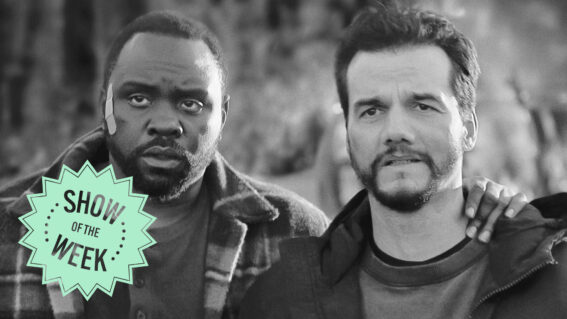Here’s the reason audiences and critics are divided over Netflix’s Dahmer series

The hugely popular Netflix series about serial killer Jeffrey Dahmer is getting very different responses from audiences and critics. Luke Buckmaster—one of the latter—explains why.
Can a movie or TV show be intelligently crafted and aesthetically well made, while also being putrid? The answer, as Netflix’s popular new series about serial killer and cannibal Jeffrey Dahmer reminds us, is of course “yes”. How many awful productions over the years have been excused under the banner of that slithery word, style? Being stylish and intellectual does not translate, ipso facto, into being ethical. In fact the most stomach-turning content is often the kind that cannot be laughed away as mere trash cobbled together by nitwits.
If your piece of Nazi propaganda happens to be brilliantly made (hi, Leni Riefenstahl) nothing can—or should—stop viewers crying foul. But when the style is there and the politics are nebulous—which is the case in the awkwardly titled Dahmer – Monster: The Jeffrey Dahmer Story—a spanner is thrown in the works, muddling people’s perceptions. This is the first reason why general audiences and critics appear to be divided on the question of whether it’s any good, articles such as this noting a stark difference between audience ratings and the Rotten Tomatoes meter.
When interpreting artistic worth, politics and ideology always trump form and content. But here it’s unclear what’s motivating the filmmakers beyond the obvious (money, ratings) and what if anything the series stands for.
They’re clearly aspiring for something more substantial than the more genre-fied shows typical of its co-creator, Ryan Murphy, such as Ratched and American Horror Story. The camerawork from cinematographers Jason McCormick and John T. Connor is slow and measured, evoking a lingering stillness and gradually unveiling vivid spaces—such as the protagonist’s apartment, which is a key location (particularly in the first episode). The acting is impressive: Evan Peters being chillingly dead-eyed in the lead role, letting the ugliness of the show colour him, and Richard Jenkins delivering one of his best performances as Dahmer’s father: horrified by his shortcomings as a parent but unwilling to entirely give up on his son.
A critic’s opinion isn’t “better” than a general viewer’s, but it should always come from a more informed place. In this instance critics should be able to draw on other works that have morally failed us, as well as those exploring difficult subjects with tact and sophistication. This is another reason for the aforementioned divide: critics have higher standards because they’ve tend to have seen a greater number of superior productions, which resist (unlike Dahmer) cheap thrills. And one more reason while we’re at it: audiences watch a show like this because they assume it’s going to be gross, while critics tend to watch under the assumption (delusion?) that they’re partaking in some kind of higher calling.
The question of whether the show glamorizes its protagonist is a tricky one. It’s clear Dahmer has a mental illness and isn’t a happy man. But that’s nowhere near enough to defend a show that reaches into the sewer, retrieving gross-out images including corpses and body parts, and fetishistically capturing the protagonist’s early fascination with dead animals. The writers attempt a moral high ground by depicting the police as dangerously inept: not exactly Keystone Cops, but people who couldn’t spot a criminal if they were dressed in a Beagle Boys outfit and came up and farted in their faces. In one scene the police take a look around Dahmer’s apartment and fail to see a corpse lying on the floor in the next room.

This allows the creators to divert focus from a central point of contention—the portrayal of a serial killer—and into a space of broad consensus (the police were incompetent, and they could have stopped him). A similar strategy was executed far more meaningfully in Justin Kurzel’s delicately made film Nitram, based on the life of the perpetrator of the Port Arthur massacre. When the protagonist goes shopping for guns and easily acquires them, Kurzel reveals his raison d’être: the film is a polemical commentary on the system that allowed a very unwell individual to become dangerously armed. In Nitram this moment changed its entire focus. The comparable element is Dahmer is half-arsed, despite great potential to make more of the fact that Dahmer lived in a predominantly black neighbourhood (and preyed on mostly gay people of colour) with scanter police resources and racist cops.
Another way to shift moral framing is to begin one way and end another. Dahmer gets a more interesting structure later on, in episode six for instance deriving into the life of a deaf character, one of Dahmer’s victims, and presenting the episode largely from his point of view (eventually bringing a kernel of truth to a stone cold lie spread by Netflix’s PR team: that the show unfolds from the perspective of victims. It does not, and this deception very much made the rounds). This strategy is reminiscent of Paul Greengrass’ film 22 July, which opens with a blood-curdling re-enactment of the 2011 Norway terrorist attacks and later becomes in part about human resilience, via a subplot involving a victim learning to walk again.
It’s harder to justify this approach in a television format, given it cannot be assumed the audience will continue watching for a show’s entire (in this instance 10 episode) arc. It’s also a question of focus. If the producers of Dahmer were serious about taking a non-exploitative approach, why not make episode six the first episode and build it out from there? We know the answer: because exploitation sells, and focusing on a serial killer gets people talking. Audiences and critics alike.














